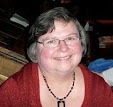 My first fascination with Highgate Cemetery came as I was reading Tracy Chevalier's Falling Angels, a novel of the suffragette movement in England, more specifically London. And then I read Neil Gaiman's Newbery winning book, The Graveyard Book that also takes place in part in Highgate. Her Fearful Symmetry has been on my "to read" list for a number of years. I have wanted to tour Highgate but have never really had the chance until now. We will be visiting there in the near future and so the impetus to get this book read NOW!
My first fascination with Highgate Cemetery came as I was reading Tracy Chevalier's Falling Angels, a novel of the suffragette movement in England, more specifically London. And then I read Neil Gaiman's Newbery winning book, The Graveyard Book that also takes place in part in Highgate. Her Fearful Symmetry has been on my "to read" list for a number of years. I have wanted to tour Highgate but have never really had the chance until now. We will be visiting there in the near future and so the impetus to get this book read NOW!The title of the book comes from the first and last stanzas of William Blake's The Tyger:
Tyger! Tyger! burning bright
In the forests of the night,
What immortal hand or eye
Could frame thy fearful symmetry?
Tyger! Tyger! burning brightThe poem contrasts the creation of the dark and light, innocence and experience, the tiger and the lamb. Niffenegger's novel is wrapped around those contrasts also as the reader witnesses dependence and desire for independence, incarnate and spectral love, and veracity and deception. Valentina and Julia are twins living in the suburbs of Chicago. Valentina is the weaker of the two. She suffers from asthma and has a malformed heart valve. Julia is the stronger and more domineering twin. Their mother Edie is also a twin, estranged from her sister Elspeth who lives in London in a flat that overlooks Highgate Cemetery. The twins receive news that there aunt has died of leukemia and left her flat and its contents to them. Even more confusing is the fact that they are required to live there for at least a year before selling it. And so the two, college dropouts at age 21 and not sure of what they want to do in life, move to London. They discover the neighbors in the house are Robert, the partner of Elspeth who took care of her as she died and Martin, a man suffering from OCD whose wife has left him to live in Amsterdam.
In the forests of the night,
What immortal hand or eye
Dare frame thy fearful symmetry?
Unsure as to the reason they have inherited the flat, Julia and Valentina take to exploring London and getting to know their neighbors, including Highgate. And then the ghost of Elspeth returns and Julia, Valentina, and Robert begin communicating with her. Elspeth is strong-willed and even in death wields influence over the three. Julia and Valentina take in a little white kitten who is accidentally killed by Elspeth who then restores its soul to him. With those powers now brought to light Elspeth and Valentina begin to consider how they might enable her break away from the overbearing Julia.
There are subplots involving Robert and his work at the cemetery (which rhymes with symmetry). He is a guide and is working on a doctoral thesis on the history of the cemetery. Martin becomes known as a recluse whom Julia is trying to help by feeding him vitamins that are really Anafranil. Martin realizes this and plays along as he attempts to break out of the holds that the OCD has on him.
 |
| Egyptian Avenue by |
Despite garnishing negative reviews, I really enjoyed this book. Of course my love of England and all things London didn't hurt. I was fascinated by the interactions of the twins and them with Robert, Martin, their parents, and of course, Elspeth. You knew the secret of the estrangement of Edie and Elspeth would eventually surface at some point. You had a suspicion of what it would be, but little did you know how it would finally manifest itself. The foreshadowing of the ending was subtle and in the surprising. A great read and a tantalizing tome before visiting the cemetery. Can't wait!


